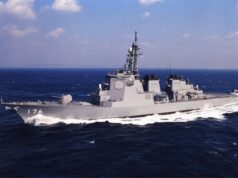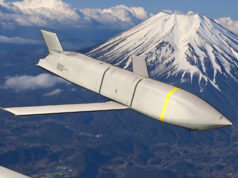New Zealand is staging one of its largest exercises of the year to test its capabilities to respond to violent unrest and natural disasters in the Pacific island states.
This exercise, hosted by Vanuatu, involves a fictitious scenario where there has been a breakdown of law and order on Epi Island, prompting the Vanuatu Government to request New Zealand’s support to restore stability. The exercise will not only test New Zealand’s military personnel in their peacekeeping abilities but also the Vanuatu Police Force and other elements of the local government in their ability to work together in a coordinated manner.
RNZN Captain Garin Golding, Commander of the Joint Task Force, said the exercise was designed to test a range of contingency capabilities in a tropical environment and therefore was ideally placed to contribute to New Zealand support to the response effort if requested by the Vanuatu Government.
Multi-role warship HMNZS Canterbury sailed from Auckland on Sunday, accompanied by offshore patrol vessel HMNZS Wellington, and will spearhead the operation. The remainder of the task force will join them in Vanuatu after flying in by Hercules.
“The contingent includes New Zealand Army units, including a light infantry platoon, medical, dental and emergency health teams, as well as divers and mine clearance teams,” Captain Golding said. “It possesses a similar capability to the forces New Zealand deployed for events such as Cyclone Pam, Cyclone Winston and the Kaikoura earthquake in New Zealand.”
In addition to their peacekeeping exercises, the contingent will also deliver and distribute 50 tonnes of aid to communities on Ambae Island that have been impacted by ongoing volcanic eruptions. A RNZAF P-3K Orion aircraft will support efforts by conducting an aerial reconnaissance of the volcano for local authorities.
Regional security missions and humanitarian and disaster relief operations make up two of the critical pillars of capability for the New Zealand Defence Force. In recent years New Zealand has worked with regional partners, such as Australia, on interventions in the Solomon Islands, Bougainville and Timor-Leste following civil unrest and undertaken numerous disaster relief operations.
Commander Joint Forces New Zealand, Major General Tim Gall, said the NZDF was always ready to assist its Pacific neighbours if asked for help.
“New Zealand has a long history of engaging collaboratively with our South Pacific colleagues and partners on matters of defence, security and protection of resources,” Major General Gall said, noting that “supporting the South West Pacific has always been a key focus for the NZDF because of the geographical proximity and cultural links with New Zealand.”








Interesting looking ship, so decided to look further into HMNZS Canterbury and I was surprised at how someone overlooked or overruled a design flaw regards those pretty little slots near the rear for the ships RHIBs:
“Canterbury weathered her first strong storm during 10 July 2007 well, though she lost one of her rigid-hulled inflatable boats (RHIB) (and almost lost the other) to waves swamping her open boat bays while near Tauranga on the way to Auckland. The RHIB was found a week later, washed ashore on Great Barrier Island, 200 kilometres (120 mi) to the north. A court of inquiry found that the loss was due to a known design flaw identified in tank testing. The flaw resulted in the loss of the RHIB and water entering the cargo deck after the doors were opened by the sea. As a result of this the doors were tied shut. The court of inquiry also reported slamming of the bow and propellers leaving the water. Options to resolve the design problems on the ship include closing the alcoves in which the ship’s boats had been stowed. At the time the RHIB was lost, the ship’s log records the weather conditions as being a wind strength of 60 knots (110 km/h; 69 mph), gusting to 73 knots (135 km/h; 84 mph), a swell of 6 metres (20 ft) (sea state six), and a completely overcast, very dark night. The alcoves are 3.3 metres (11 ft) above the waterline and were swamped by the waves and because the ship was experiencing severe motion, rolling up to 28 degrees to port, at a roll frequency of 11.5 seconds. The ship’s anti-roll system will not function when the period of the ship’s roll is less than 11.9 seconds. As a result, work was begun to relocate the boats to a less vulnerable location”
http://www.nzdf.mil.nz/downloads/pdf/public-docs/cty-coi.pdf
Yeah, just move the ships, don’t bother addressing the flaw, SMH.
Are they still nicking our sailors? I used to see adverts in Navy News looking for British recruits to join.
Don’t know about matlows, but a lot of my mates have buggered to join the Ausi army.
And there should be a ‘off’ after buggered.
?
?